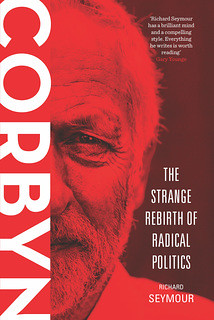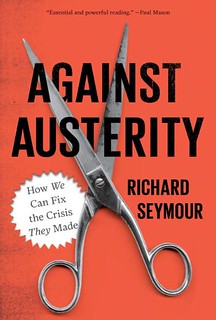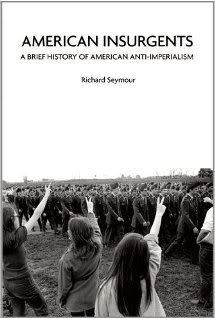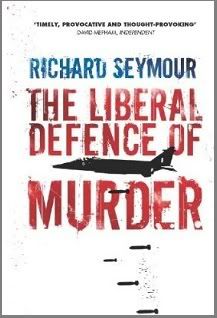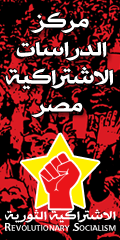Thursday, January 06, 2011
The new spirit of armed combat posted by Richard Seymour
"To summarise, then. Let's say our eight thousand men[!], coordinating themselves via their wikis, voting on a dozen on-the-hoof strategic propositions, utilizing their collective cleverness and experience (instead of suppressing it under the lid of feudal command) - that our eight thousand, because they had drawn on all eight thousand as a tactical resource as well as a fighting force - had thoroughly defeated an army three times our size. Let's say they had a dozen armoured- and tank-cars; and air support; and bigger guns, and better and more weapons. But let's say they were all trained only to do what they were told, and their whole system depending on the military feudalism of a traditional army, made them markedly less flexible; and that each soldier could only do one thing where we could do many things.
"Anyway, we beat them.
"Here's something else: they couldn't believe we had beaten them, even long after we had done it. I don't mean 'they couldn't believe it!' as a periphrasis for general astonishment. I mean they literally could not believe it. It did not seem real to them. Something was wrong somewhere, and the wrongness must be somewhere else than the feudal logic of old-style military thinking (they outnumbered us by so much! They were better armed by so much! They were a professional experienced army! And so on). But we beat them for all that.
"There were three hours, give or take, of further fighting, although it was intermittent and we neither killed nor were killed in large numbers. They held out that long, I suppose, hoping that reinforcements could be sent up from Deepcut, where another Regular Army corps was fighting another NMA. But neither that force, nor the much larger body of men and machine to the north, was free to come to their aid. After it became apparent that nobody was coming the battle wound itself up smartly. We selected a dozen negotiators - some NMAs like to decide on negotiators before battle, but I've always thought that a short-sighted thing to do (what if they get killed or wounded in combat? It takes no time to have the wiki randomly identify a dozen troopers, and we're all, more or less, equally capable when it comes to such negotiations.) Our negotiators went in and talked to the surviving ranking officers, and terms were agreed. We confiscated their remaining cars, and took some civilian automobiles as well; and then we loaded up the weapons we had seized into those and took them away.
"We had a quick wiki debate about what to do with these two thousand unarmed men, some wounded (some wounded badly) and some not. If our enemy had been like us, their well men would have tended their unwell and everything would have gone better for them; but since it was a feudal force it depended upon specialized medics to look after the sick. Of course it is in the nature of such specialists that there are always too many of them, with not enough to do, in peacetime; and always too few, with too much to handle, in battle.
...
[After success in battle, the new model army prepares to ship out.]
"We are at our weakest when it comes to mass transit of this sort. It's not what we are best at doing. Moving in swarm, thousands of individuals making their own myriad ways, is our natural mode of transport. Moving en masse puts us in danger. But I do not offer this to you as a tip, since if pressured tactically at such a moment - should you, in plain language, see to take advantage of that situation - we can easily eliminate the problem by killing our prisoners and dispersing ourselves. We would prefer not to, but it is an option available to us: and in that case the problem is removed. The only difficulty would be in killing such a large body of people quickly enough not to be disadvantage tactically; but here the nature of NMA combat structures - the fluid and rhizomatic nature - was on our side. A feudal army would, I suppose, select a number of men as an execution detail, and work methodically through the mass of prisoners. But we were all armed, and there were more of us than the prisoners; so once the vote was taken it would be a simple matter for each member of the NMA to pick a prisoner, dispatch him, such that it would all be over with a single boomingly multi-tracked gunshot. We are all equally capable, and responsible." (Adam Roberts, New Model Army, 2010, pp. 35-7 & 42)
The new model army is, as you see, a network without hierarchy (not all networks are necessarily so); an emergent intelligence, connected by real-time peer-to-peer connections; a democratic Leviathan, made possible by the internet and the wiki. It is the swarm. And now here is Hardt & Negri's version of the swarm:
Here we find ourselves in front of a sort of abyss, a strategic unknown. Every spatial, temporal, and political parameter of revolutionary decisionmaking a la Lenin has been destabilized, and the corresponding strategies have become completely impractical. Even the concept of "counterpower," which was so important for the strategies of resistance and revolution in the period around 1968, loses its force. All notions that pose the power of resistance as homologous or even similar to the power that oppresses us are of no more use.
...we know that capitalist production and the life (and production) of the multitude are tied together increasingly intimately and are mutually determining. Capital depends on the multitude and yet is constantly thrown into crisis by the multitude's resistance to capital's command and authority. ... In the hand-to-hand combat of the multitude and Empire on the biopolitical field that pulls them together, when Empire calls on war for its legitimation, the multitude calls on democracy as its political foundation. This democracy that opposes war is an "absolute democracy. " We can also call this democratic movement a process of "exodus," insofar as it involves the multitude breaking the ties that link imperial sovereign authority to the consent of the subordinated.
When a distributed network attacks, it swarms its enemy: innumerable independent forces seem to strike from all directions at a particular point and then disappear back into the environment. From an external perspective, the network attack is described as a swarm because it appears formless. Since the network has no center that dictates order, those who can only think in terms of traditional models may assume it has no organization whatsoever-they see mere spontaneity and anarchy. The network attack appears as something like a swarm of birds or insects in a horror film, a multitude of mindless assailants, unknown, uncertain, unseen and unexpected. If one looks inside a network, however, one can see that it is indeed organized, rational, and creative. It has swarm intelligence.
Recent researches in artificial intelligence and computational methods use the term swarm intelligence to name collective and distributed techniques of problem solving without centralized control or the provision of a global mode. Part of the problem with much of the previous artificial intelligence research, they claim, is that it assumes intelligence to be based in an individual mind, whereas they assert that intelligence is fundamentally social. These researches thus derive the notion of the swarm from the collective behavior of social animals, such as ants, bees, and termites, to investigate multi-agent-distributed systems of intelligence. Common animal behavior can give an initial approximation of this idea. Consider, for example, how tropical termites build magnificent, elaborated domed structures by communicating with each other; researchers hypothesize that each termite follows the pheromone concentration left by other termites in the swarm. Although none of the individual termites has a high intelligence, the swarm of termites forms an intelligent system with no central control. The intelligence of the swarm is based fundamentally on communication. For researchers in artificial intelligence and computational methods, understanding this swarm behavior helps in writing algorithms to optimize problem-solving computations. Computers too can be designed to process information faster using swarm architecture rather than a conventional centralized processing model.
The swarm model suggested by animal societies and developed by these researchers assumes that each of the agents or particles in the swarm is effectively the same and on its own not very creative. The swarms that we see emerging in the new network political organizations, in contrast, are composed of a multitude of different creative agents. This adds several more layers of complexity to the model. The members of the multitude do not have to become the same or renounce their creativity in order to communicate and cooperate with each other. They remain different in terms of race, sex, sexuality, and so forth. What we need to understand, then, is the collective intelligence that can emerge from the communication and cooperation of such a varied multiplicity. Perhaps when we grasp the enormous potential of this swarm intelligence we can finally understand why the poet Arthur Rimbaud in his beautiful hymns to the Paris Commune in 1871 continually imagined the revolutionary Communards as insects. It is not uncommon, of course, to imagine enemy troops as insects. Recounting the events of the previous year, in fact, Emile Zola in his historical novel La Debacle describes the “black swarms” of Prussians overrunning the French positions at Sedan like invading ants, “un si noir fourmillement de troupes allemandes.” Such insect metaphors for enemy swarms emphasize the inevitable defeat while maintaining the inferiority of the enemy-they are merely mindless insects. Rimbaud, however, takes this wartime cliché and inverts it, singing the praises of the swarm. The Communards defending their revolutionary Paris against the government forces attacking from Versailles roam about the city like ants (fourmiller) in Rimbaud’s poetry and their barricades bustle with activity like anthill (fourmilieres). Why would Rimbaud describe the Communards whom he loves and admires as swarming ants? When we look more closely we can see that all of Rimbaud’s poetry is full of insects, particularly the sounds of insects, buzzing, swarming, teeming (bourdonner, grouiller). “Insect-verse” is how one reader describes Rimbaud’s poetry, “music of the swarm”. The reawakening and reinvention of the senses in the youthful body-the centerpiece of Rimbaud’s poetic world- takes place in the buzzing and swarming of the flesh. This is a new kind of intelligence, a collective intelligence, a swarm intelligence, that Rimbaud and the Communards anticipated. (Michael Hardt & Antonio Negri, Multitude, 2004, pp. 90-3, italics in original).
Labels: anticapitalism, autonomism, capitalism, class, empire, hardt, multitude, negri, zapatistas


